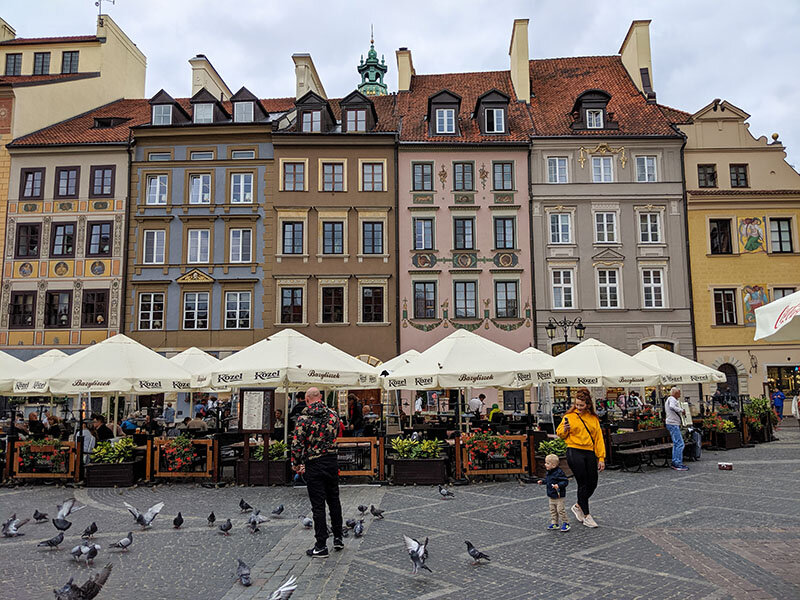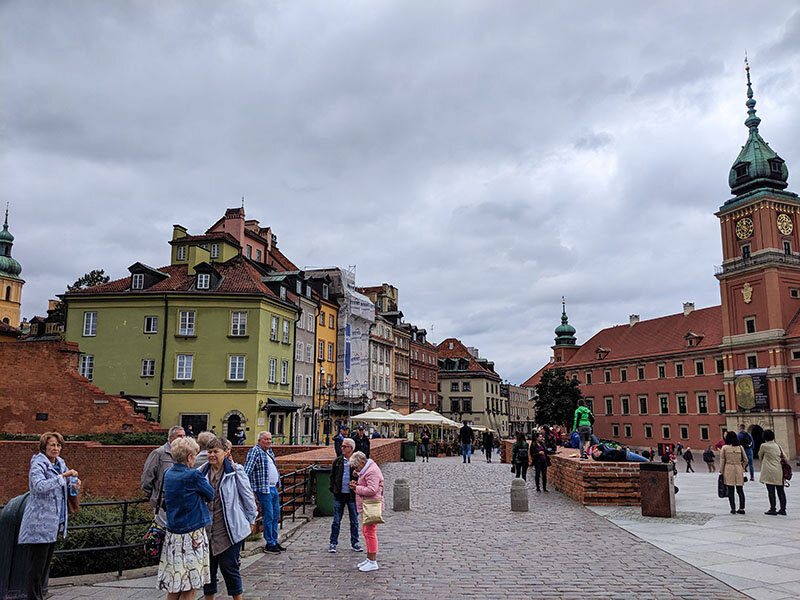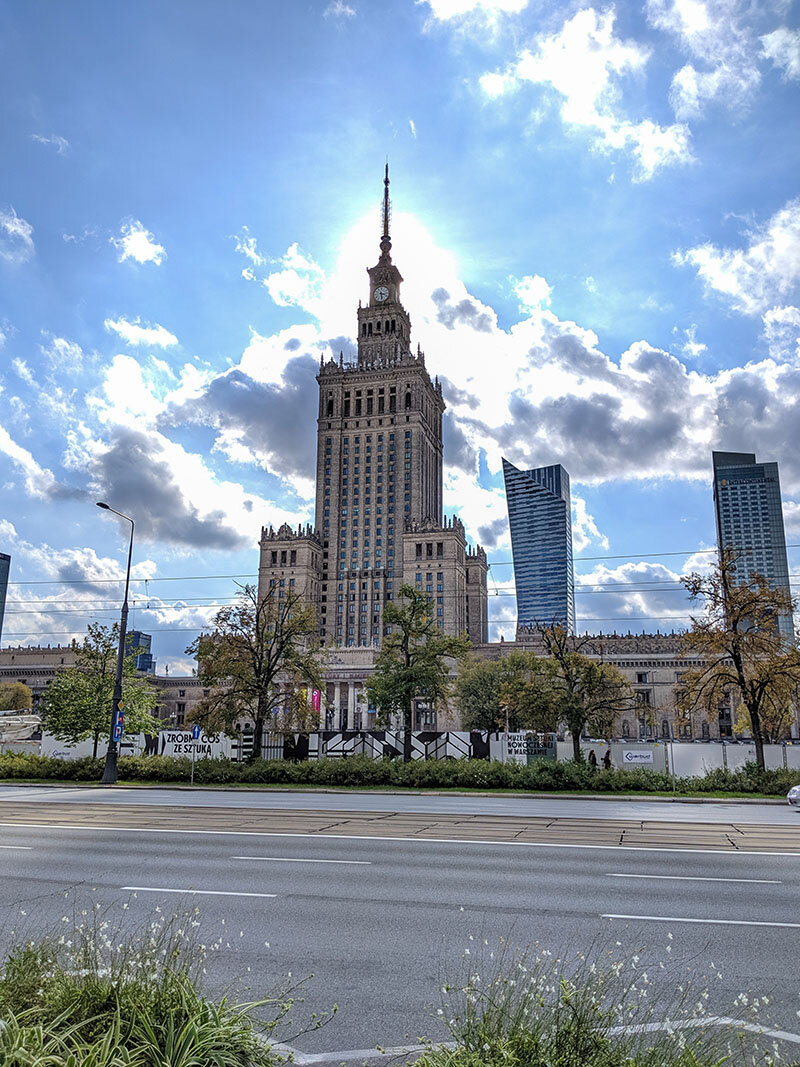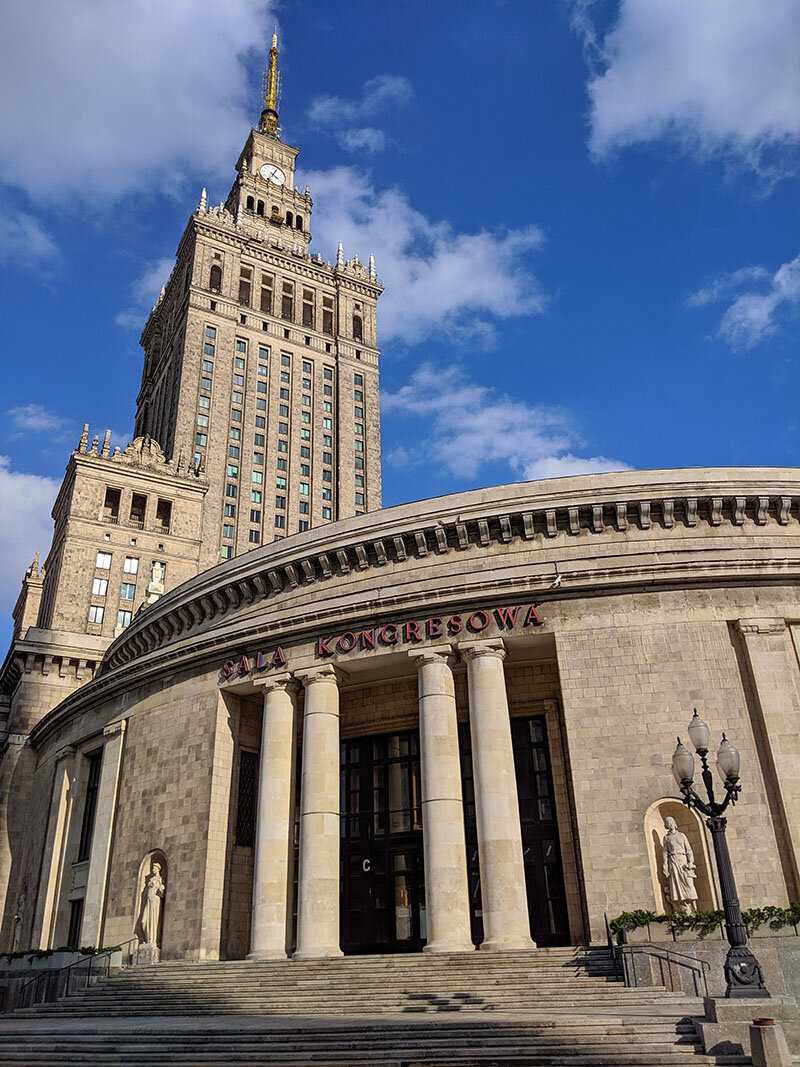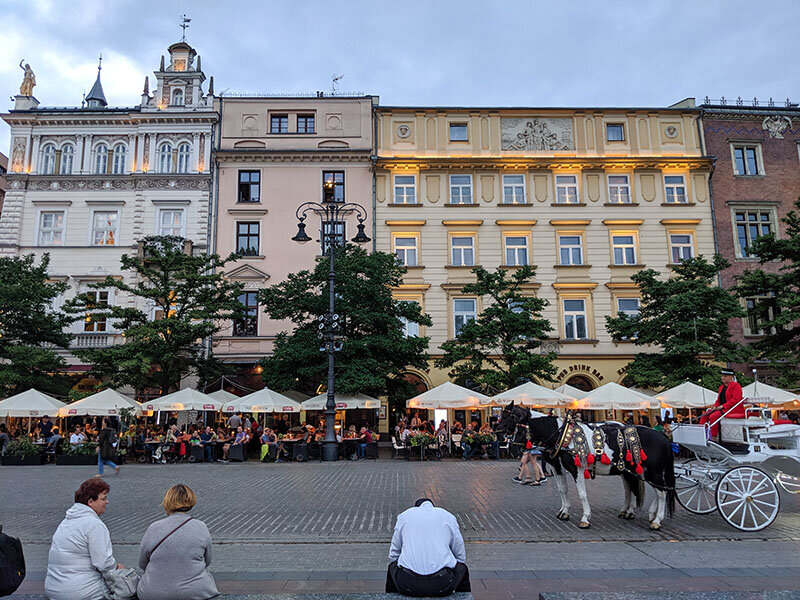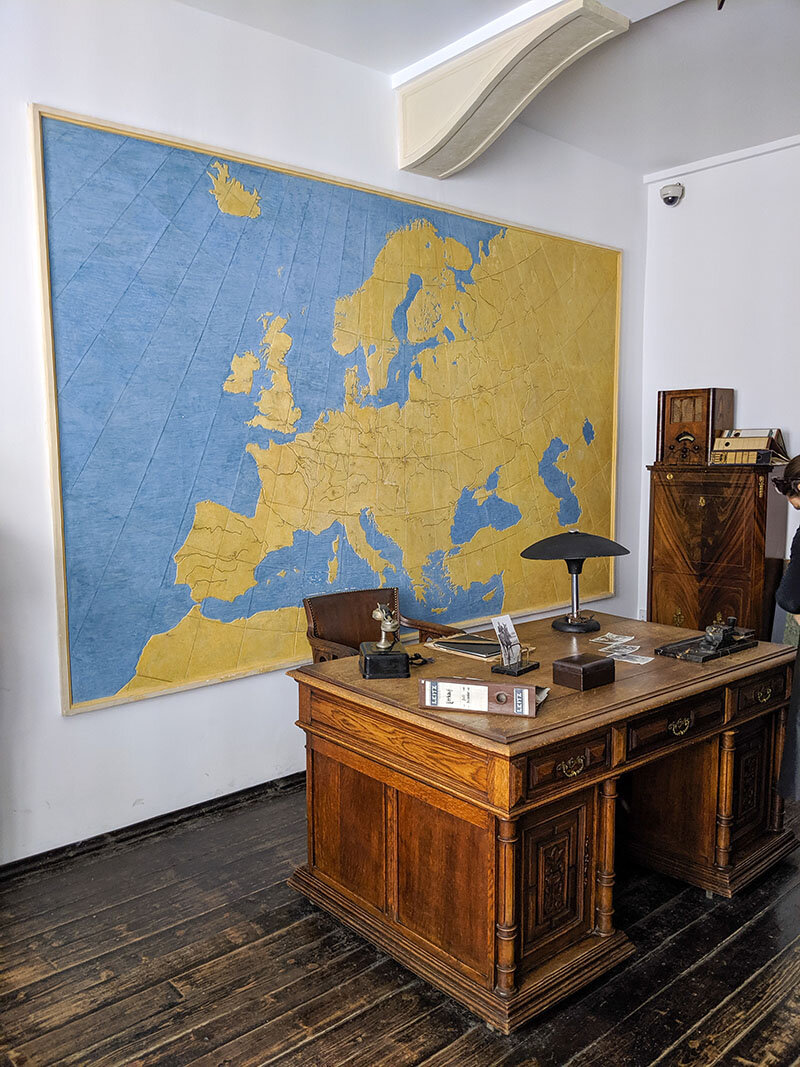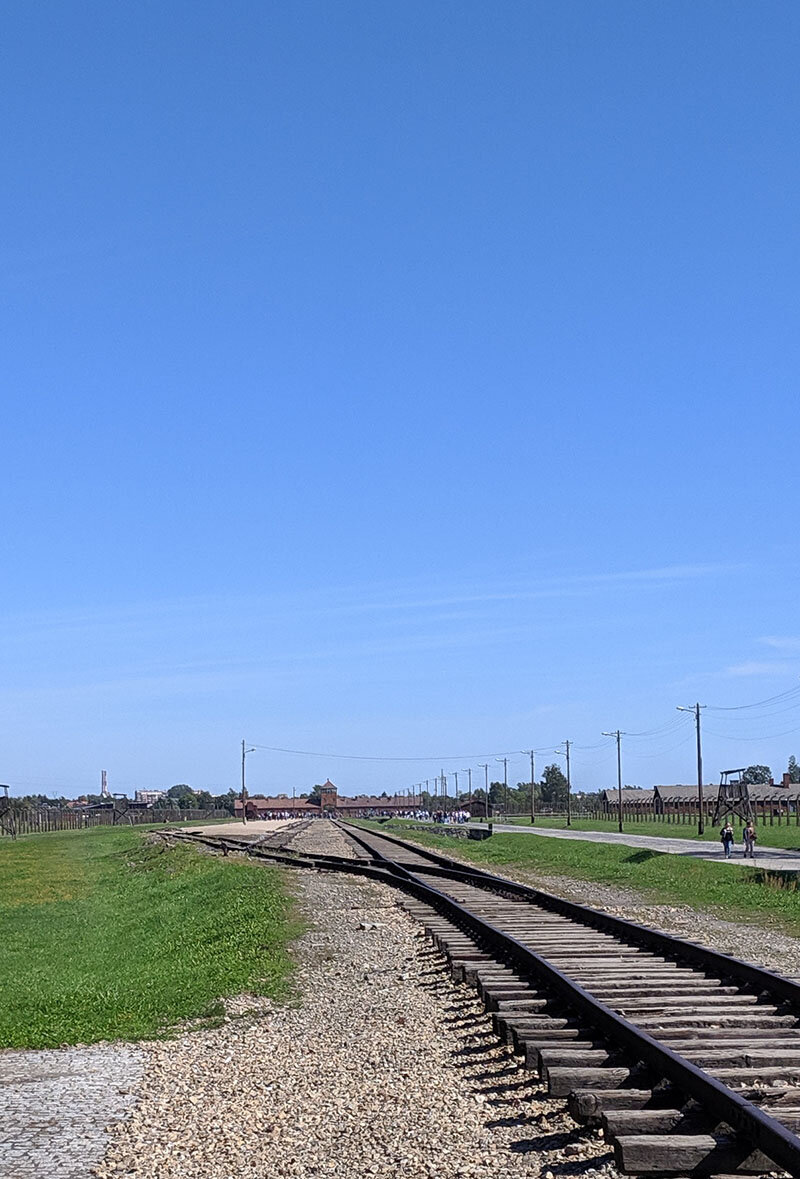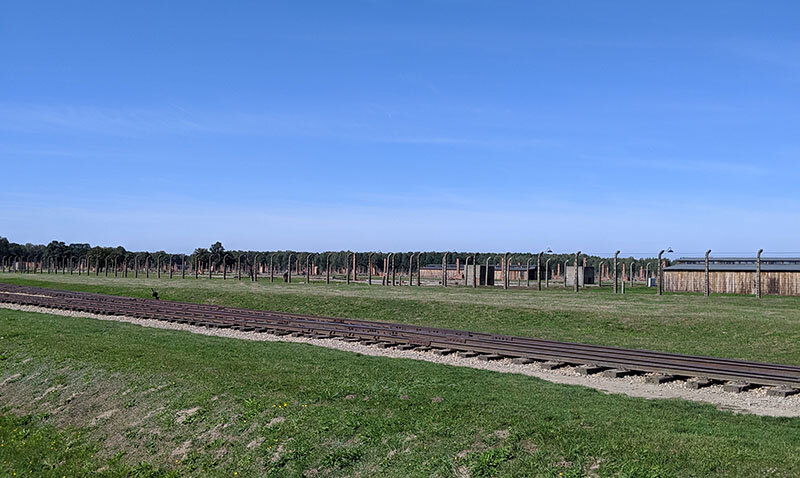We left Ian’s family in Berlin and caught a FlixBus to Warsaw. It was a long ride, about seven hours with a few stops. I didn’t know what to expect, and the drive surprised me. For the most part it was all tall dark woods and green fields.
We got into Warsaw late, and had to search for our Uber driver as he decided to park on the interstate with his flashers on, waiting for us, instead of drive onto the frontage road we had set up as our pick up point. We found him and weren’t hit by a speeding car, so it all worked out.
In the daylight, we saw that our building was a massive block of grey concrete, identical to about 6 other buildings around it—from what we could tell they were holdovers from the Soviet power. But they were communities, with kids playing in the playgrounds that connected them and people laughing and chatting on benches nearby. Restaurants rented out the bottom floors and patios spilled out into the alley ways.
We wandered toward Warsaw’s Old Town, and on our way there we realized that stoplights aren’t always a thing—drivers just stop for you even if it’s a six-lane highway.
Our first Polish meal was to die for: we had three different kinds of pierogi (bacon and potatoes, cabbage and mushroom, and pork, red beans, and corn), bigos (old Polish style hunter stew with sauerkraut, pork and dried plums), and żurek (soup in a bread bowl with smoked bacon, horseradish, egg, and Polish sausage.
We also ordered a warm beer (Grzane piwo), which we’ve been finding warm alcohol to be popular in Eastern Europe. It’s not just warm, it has spices added to it so it’s reminiscent of a Christmas type cocktail, using things like cloves, cinnamon, ginger, etc. It was tasty!
After lunch we explored Old Town. This section of town was rebuilt after the second world war as it was completely obliterated after the Warsaw Uprising—the few months in 1944 that the Polish reclaimed their city and hunkered down to fight off the Germans. It’s an impressive part of the city, it looks old and has a charm that doesn’t look recently manufactured. They rebuilt as much as they could from the remnants of the old buildings. I read somewhere that you’ll hear from locals that it’s more authentic and historically true today than it was originally, which is a funny way of putting it.
Afterwards we meandered toward the new skyscrapers and business part of town. We saw the changing of the guards at the memorial of the Unknown Soldier. It is housed in what little remains of the large palace that once stood there, destroyed by the Nazis during the war. There are many pictures of large Nazi gatherings in that plaza, with their banners hanging off the palace. Now, there’s nothing but the memorial and a nice park situated behind it.
Alongside the skyscrapers and shopping malls is the Palace of Culture and Science—a massive tower surrounded by a complex of other impressive buildings and a gift from Stalin after the war, when he was ‘ruler’ of the USSR and Poland becoming a satellite territory. It’s an impressive and controversial building, with many deeming it beautiful AND ugly. Many hate the significance of it, and the reason it’s there at all.
The next day we went a museum dedicated to the Warsaw Uprising. While the layout of the museum was terribly confusing and had us wandering in circles and up and down flights of stairs trying to find exhibits and follow some type of chronological order, we did learn an incredible amount of information. It was one of the first times I’d heard that the Soviet’s at the time had a hand in suppressing and killing so many of the Polish people. The discovery of a mass grave of Polish political party members have been attributed to the work of the Russians. During the uprising, Stalin refused to allow Allies dropping in supplies to the city to land on his airstrips, and he himself did not send much and in aid and what he did send was not sent in with parachutes, so it would often just smash into the ground and ruin whatever supplies were being sent. They had an initial deal at the start of the war with Germany, to invade Poland from the East. And then of course the occupation that followed and the communist government in place until 1989.
The following day we went on a long walk through a park and saw the Palace on the Isle.
Then we rented bikes to head down to Jan III’s Palace at Wilanów. It was rough going there, my rental bike got a flat tire and Ian’s gears kept slipping.
Then on the way back I wiped out hard on an electric scooter which prevented us from heading to the Praga neighborhood for a night out.
In the morning we took a bus to Kraków, a city that quickly stole our hearts. We stayed in an old building in the what was the Jewish Quarter. We spent every day walking to and through the main square, as well as visiting a bar a few blocks off the square each night. There was so much going on in the square you could sit there all day and never get bored.
The next day we went to Schindler’s Museum, which was a great museum and well-designed. Each room was decorated as a different business or place from the time, and we learned a great deal about the effect of the war on Kraków. It was designated as the seat of the General Government set up by the Germans, which is perhaps why many of the buildings remained intact. We learned about how they walled the Jewish people into the Jewish Quarter of the city, with coffin like shapes every now and then along the walls. They starved in the ghetto, and were forced to live on top of each other. When the Nazis would come through and round up families to take to the camps, they would rip them from their homes and even threw children out of windows. We learned about Oskar Schindler, a German in the Nazi party who took over some factories that had been owned by Jewish business men. He employed Polish and Jewish workers, and gave them food and medical attention that was nearly impossible to find elsewhere. We watched some interviews with people that had worked at his enamel factory, and they believe that he saved them from the inevitable fate that was falling on so many in their community.
Oskar Schindler’s office
We then ventured over to Wawel Palace. It is a hodgepodge of architectural styles, its own village on top of a hill overlooking the city. I enjoyed the dragon heads on the water spouts, and legend has it that the bones of a dinosaur were carried to the castle in medieval times and were explained to be that of the local dragon. He was rumored to have lived in a cave at the base of the hill.
Our last day in Kraków we took a bus out to Auschwitz. Doing our research, we saw that we had to take the earliest bus possible, 6:30am, to get in line and secure a tour in English for that morning. In retrospect, we should have booked online a few weeks in advance so we could have just shown up and gone in at our tour time.
What’s there to say about Auschwitz—it’s heartbreaking and just incredibly hard to wrap your mind around. It’s sobering, moving, hard to describe—so many people were murdered, and by so many people who either carried it out or stood by and let it happen. The sheer number of people who were murdered and the ways in which they were murdered are unfathomable.
The next morning we rented a car and headed south for the High Tatras, a mountain range that exists on the border of Poland and Slovakia.
